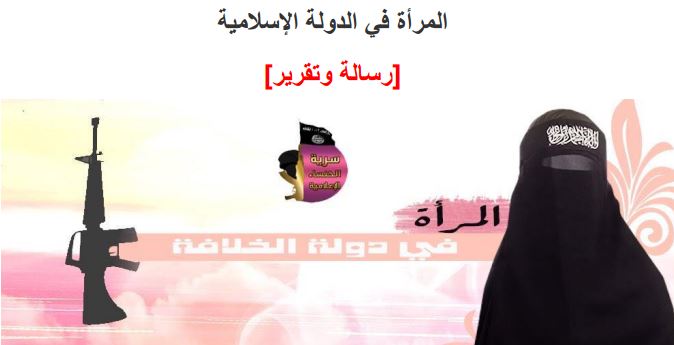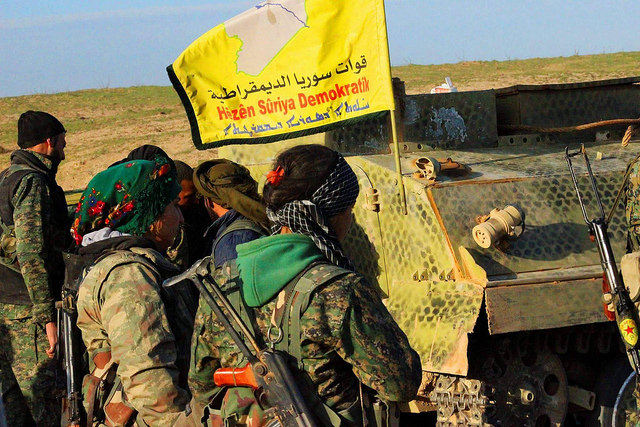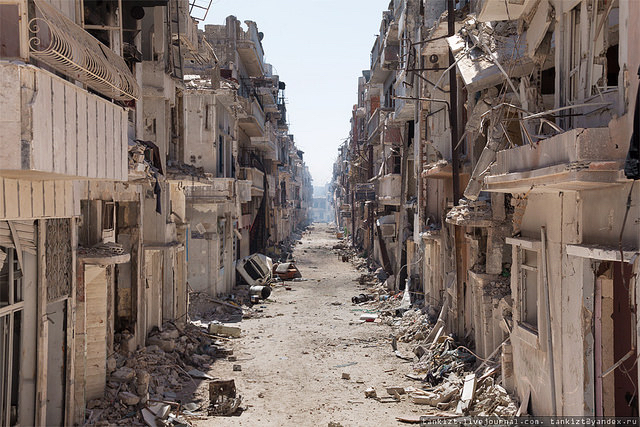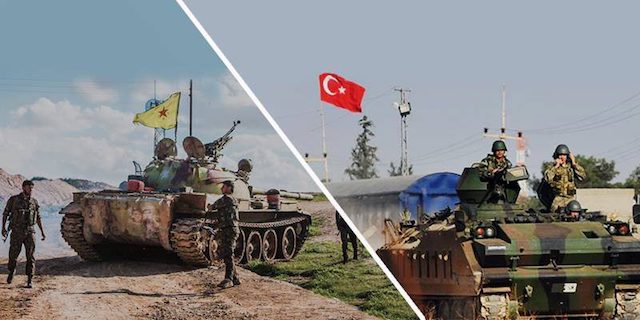The al-Khansa Brigade, which has become infamous for recruiting female jihadists, released an Arabic-language manifesto on January 23rd. It is likely no coincidence that this was the same published on the same day as death of Saudi Arabi’s King Abdullah. It is obviously targeted at Arab women, hailing from the Persian Gulf.
British anti-extremist think tank Quilliam Foundation released an English translation of the text, mainly because “it ran the risk of slipping through the net of non-Arabic speaking Western analysts.” Quilliam is nodding towards the fact that most Western analysis of the group focuses on its English-language propaganda and Western recruits. This is despite the fact that the bulk of Islamic State’s ideological material is not directed at Western audiences. One Arab country, Tunisia, boasts more IS recruits than every Western nation combined.
Regardless, al-Khansa is still best-known for its its purported Western members, most recently, the three London schoolgirls who were confirmed to have joined the group earlier this week. This makes the mistake of privileging Westerners fighting with the group over non-Westerners, which betrays a subtle imperialism in many analyses. Al-Khansa’s manifesto is interesting because it was not meant for Western audiences. For instance, rather than simply arguing that women should be domesticated, which is usually its characterization in Western media, IS goes further to say that “Islam does not ordain the forbidding of education or the blocking of culture from women” before launching into a detailed description of adequate education in home economics, religious sciences, and certain professions. The latter is said to include medicine and teachers, so long as women adhere to IS’ interpretation of Shariah, as well as jihad, in wartime contexts when it’s a last resort, such as in Iraq, and Afghanistan.
Clearly, this was meant for a totally different audience. This does not make the manifesto more convincing than other IS material. Its description of how women’s life operates in Islamic State is clearly at odds with a reality of violence and human rights violations. The point is how it structures its argument, which is far more elaborate, and also begins with an entire section that explains its theoretical issues with Western civilization. Islamic State doesn’t do this when it is addressing Westerners, mainly because much of its propaganda for these audiences are explicitly designed to repulse them. This is likely because of the type of recruit that Islamic State is attempting to extract from different settings.
If this manifesto is any indication, Islamic State wants to appeal to nihilistic Westerners and Middle Easterners, for whom the text reads entirely different. Indeed, to the degree that it addresses Europeans, it’s a failure. This is not a text written for Muslims in London. It’s meant for deeply religious women in the Gulf monarchies who privately reject many aspects of modernity as it is being pursued in the GCC, and believe that these critical sentiments are not being adequately expressed in daily life. Consider this quote on the hijab:
“Further, pure women are castigated by the media who projected unjust images of them, and they were stigmatised as being backwards and retrograde, while the immodest are said to be civilised or cultured. This is the overwhelming picture in the Arab media, which is as it was in Iraq.”

Who is the audience here? It must be religious Muslim women who are exhausted with commodity fetishism, and narratives of sexual liberation that are obsessed with overthrowing religious morality, rather than allowing them sexual autonomy. The women who are being targeted are those who reject the seemingly decadent cosmopolitanism of their elites, and seek another societal project. The only thing that the manifesto needs to do from there is make the argument that that an artificial image of Islamic ethics has been overthrown in favour of hedonism. It is filled with language that addresses this point, and not only in a decline of Islam as a paradigm for gauging societal morality. It is also critical of wage labour as a form of female liberation, and the very notion of aesthetics being liberating when it still relies on deeply alienating standards of beauty and ugliness (“This urbanisation, modernity and fashion is presented by Iblis in fashion shops and beauty salons,” where Iblis seems to be a stand-in for modernity.)
Obviously, Islamic State’s vision doesn’t stand up to critical scrutiny. But what is important is that it provokes critical questions about the very nature of gender relations in monarchical settings, where such discussions are usually repressed. This is what must be compelling about the overly rosy firsthand accounts the manifesto gives in sections two and three. There is a perverse feminism to the text that rejects excessive materialism, and then makes the argument that insufficient religiosity, and a collapse in traditional gender relations, can account for this abstract social decline. This only works because its audience doesn’t usually come across elaborate arguments for alternative societies that aren’t Islamist ones. Islamic State therefore designs itself to be a hope that these women can cling to in an era that seems to have left their religiously-tinged skepticism behind.
Interestingly though, even as the Al-Khansa manifesto addresses women’s concerns, it still centers on men. It argues in an early section that the decline of traditional women’s roles is a result of men having insufficient means to realize themselves, which causes women to collapse as their support system:
“The problem today is that women are not fulfilling their fundamental roles, the role that is consistent with their deepest nature, for an important reason, that women are not presented with a true picture of man and, because of the rise in the number of emasculated men who do not shoulder the responsibility allocated to them towards their ummah, religion or people, and not even towards their houses or their sons, who are being supported by their wives. This idea has not penetrated the minds of many women. This has forced women away from their true role and they do not realise it.“

What is a “true picture of a man”? It is implicitly an Islamic State man, but it is also implictly a man who has not been tainted by the effects of modernity. Once again, we also have to remember the setting. The GCC is the processes of modernity kicked into massive overdrive, through undoubtedly post-modern processes of Gulf Futurism like unfettered innovation, mercenary armies, and frenetic banking activities. It is likely because of its different audience that we get a glimpse into Islamic State’s actual theoretical and ideological opposition to these phenomena, rather than simply half-literate ramblings about Western vapidness.
The entire first section is a polemical rebuttal of the West that although it isn’t elaborate, mainly because this was written as a popular text, manages to channel much the same spirit as established Islamic fundamentalist critiques from thinkers like Sayyid Qutb and Abu Ala’a Mawdudi. The problem is described as one linked to the secular rationalism underpinning modernity, and how it displaces Islamic metaphysics, without providing an antidote to its own unchecked tendencies towards violence and disillusionment.
Those who reproduce these value systems are condemned as “soldiers of Iblis” that send women away from Paradise “under the guise of development, progress, and culture” so they can “toil in agony and fatigue.” The manifesto reserves special disdain for the Saudi Royal Family, which it calls “Al Salul.” The Saudis are vehemently criticized not only because Islamic State wants Saudi women, but also because of its insistence on monopolizing modern Islamic spiritual power, without seeking to fundamentally retool the framework on which modernity is based. The name “Al Salul” is actually a reference to the Medinan polytheist Abdullah ibn Ubai ibn Salul, who is frequently described in religious commentary as the “chief of hypocrites.” It’s used here for obvious reasons.
Quilliam doesn’t seem to take this complexity seriously, instead dismissing it in the following:
“The West’s obsession with studying “the brain cells of crows, grains of sand and fish arteries” is deemed a distraction from the fundamental purpose of humanity – to worship God. This, the author(s) argue, has sullied humanity’s purity. In the same breath, though, they also insulate themselves from accusations of hypocrisy by claiming that those sciences “that people need, that help facilitate the lives of Muslims and their affairs are permissible”. Such hypocrisy is at the root of all extremist Islamist thinking.”
Is hypocrisy the right word here? Maybe to an extent. Jihadism can be very tenuous when it comes to logical consistency. At the same time, does Islamic State ever say that it rejects modernity altogether? There isn’t much evidence for that. Rather, like Qutb and Mawdudi, its opposition to modernity seems to be rooted in the value systems that underpin it, not the fruits of modernity itself. This is why Islamic State has no problem with being opposed to Western iconography, at the same time that it uses Twitter to promote those beliefs.
It seems as though Quilliam is in line with many analysts in presuming that IS wants to destroy modernity because of the atavistic barbarism of its actions. This is dangerous, because it is an inaccurate reading of the problem. Neither Qutb nor Mawdudi were opposed to modernity per se. Rather, the question was about the forces governing modernity, and the nature of the ummah within it. Islamic State follows suit, which isn’t hypocritical. It is a consistent reevaluation of the various aspects of our market-driven industrial society, with the added complication that many post-modern cultural trends like drug use, and the rise of alienating computer technology, also offend IS recruits’ sensibilities. The problem isn’t the modern world. It is how it is constituted.
What Qutb, Mawdudi, and a swath of thinkers like them criticized was specifically the displacement of a fantastical vision of Islam as the fundamental guiding principle of social relations. Their problem was a world seemingly devoid of metaphysical meaning, which got articulated in a platform that pushed reactionary Islamism as an antidote for social ills. ISIS is therefore in a theoretical tradition that proposes an alter-modernity. Following suit, its vision of womanhood is an alter-womanhood. It laments how women have been cut off from allegedly “natural” roles as motherhood and familial support that have no direct relationship to economic production, and its solution is a new society that is infused with religious mythology.
If Quilliam’s goal is to counter extremism, then it is especially important to be clear about this. There is a reason why this manifesto appeals to its intended audience. We have to remember the historical context in which Islamic State is able to recruit people in the region. The vicious crackdowns that ended the Arab Spring also crushed serious attempts to propose alternative ways to approach modernity. This was certainly the case in the Gulf monarchies, many of which didn’t even get a chance at serious democratic discussion. Are we really surprised that IS’ form of alter-modernity has become appealing for some people? It indicates that there is a great desire for modernity to be reevaluated as a social project, and that this will happen, with the only question being the exact ideological framework in which alternative visions will express themselves.
Photographs courtesy of Quilliam Foundation, 岑 寂, and Al Jazeera English. Published under a Creative Commons License.





